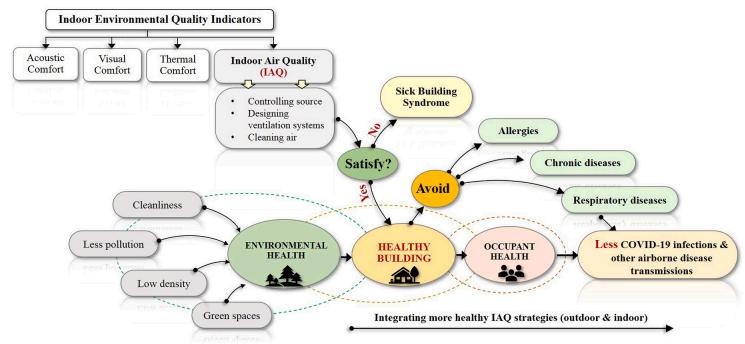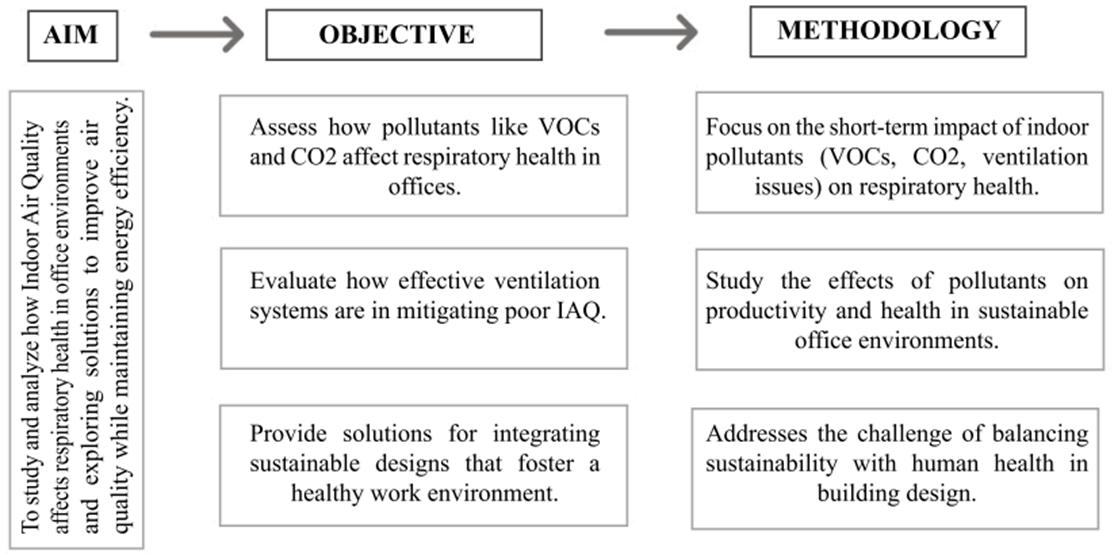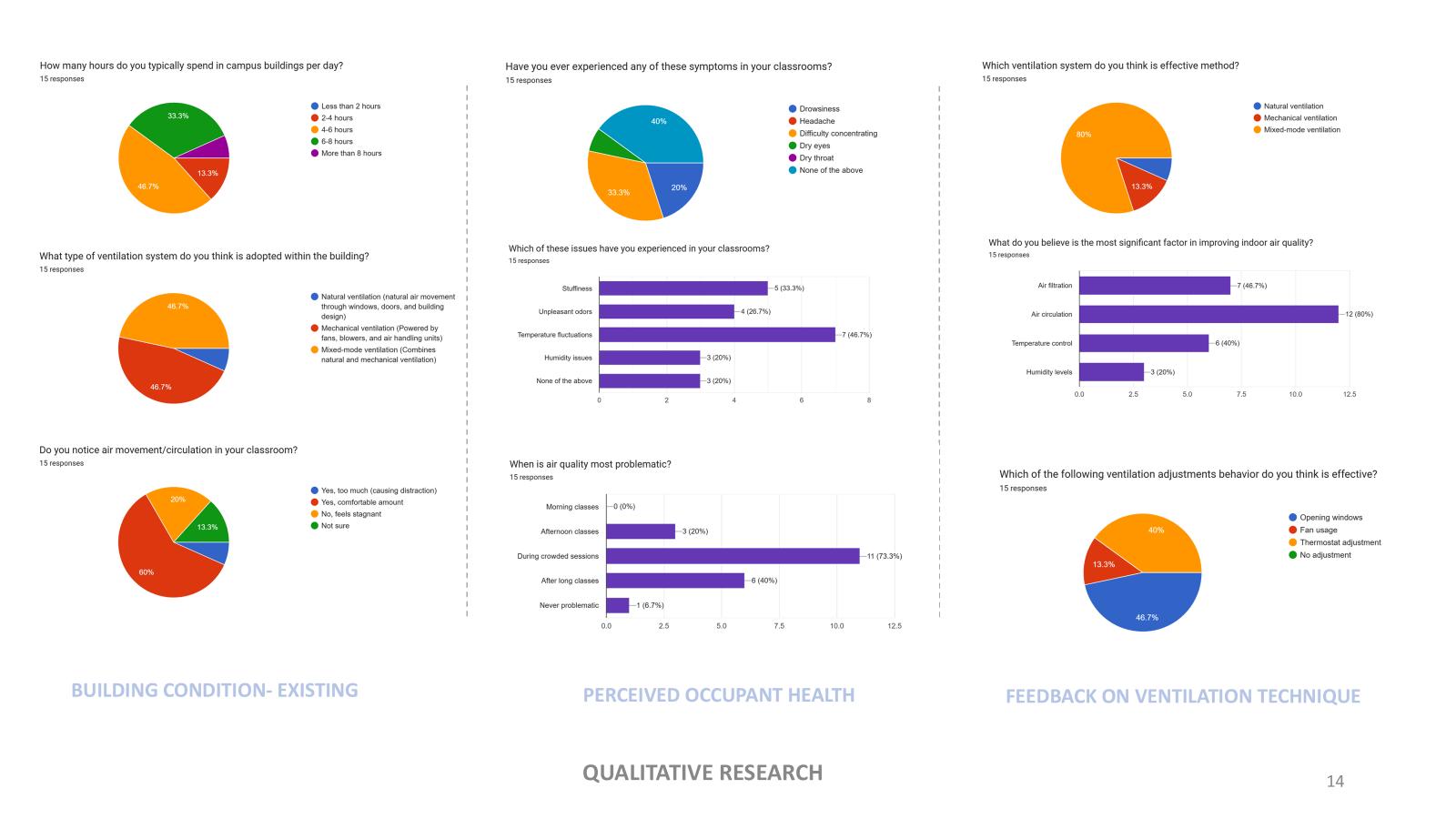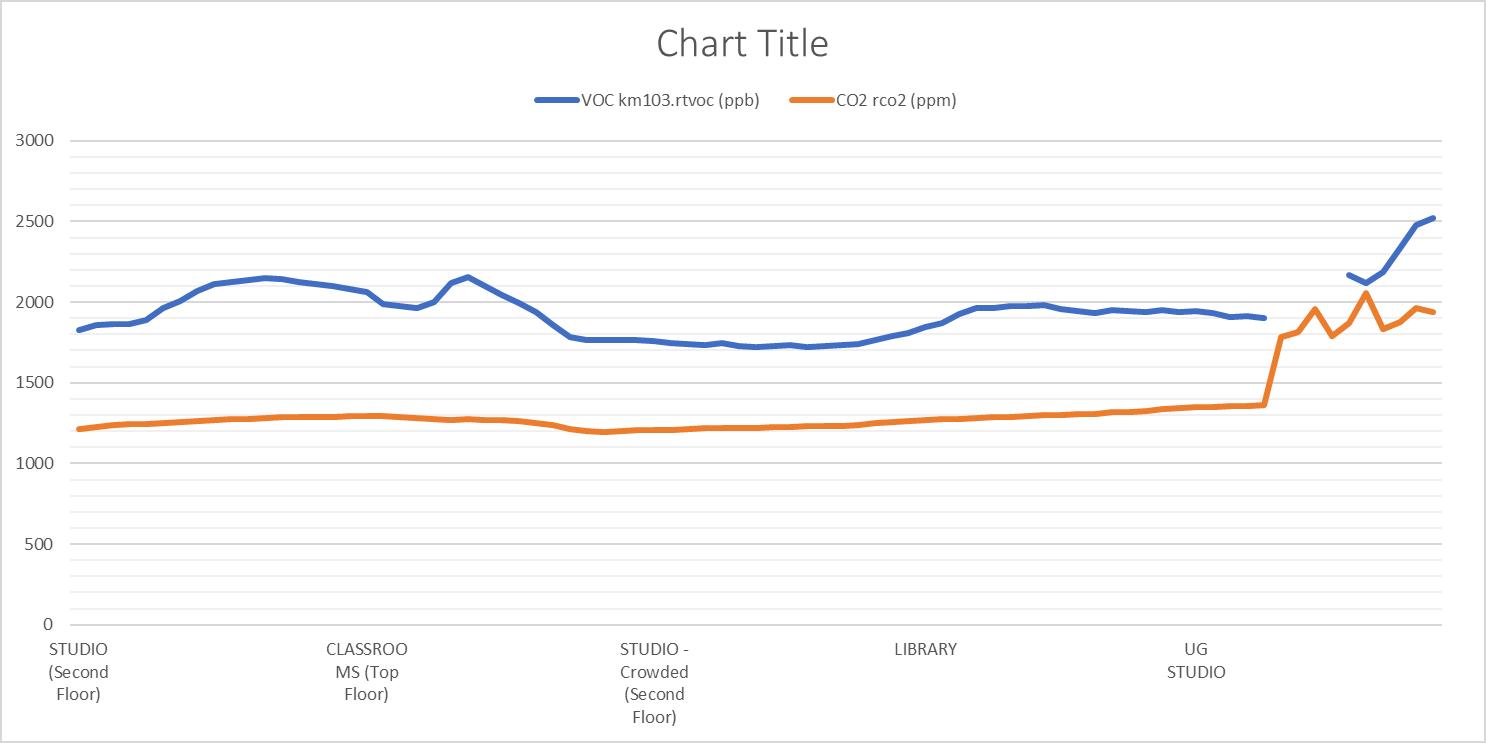IndoorAirQualityAndItsInfluenceOn
RespiratoryHealthInAnOfficeEnvironment
VaijayanthiKrishnakumar(801419252)
ABSTRACT
This pilot study explores the impact of indoor air quality (IAQ) on respiratory health within office environments, focusing on the role of pollutants and ventilation systems It examines key sources of indoor pollutants, particularly volatile organic compounds (VOCs) and carbon dioxide (CO₂), and their implications for occupant well-being and perceived respiratory health The research aims to identify pollutant sources, such as emissions from building materials, office equipment, and ventilation inefficiencies, and to propose sustainable solutions for improvingIAQ.Byemphasizingtheimportance of efficient ventilation and sustainable material selection, the study provides actionable insights for creating healthier indoor environments, balancing sustainability with occupant comfort and well-being, andsupportingmoreeffectivedesignpracticesinofficesettings.1
1.0INTRODUCTION
Indoor air quality (IAQ) describes the state of air within buildings and its impact on the health and comfortofoccupants.Itinvolvesadynamicinterplayofvariousfactorsinfluencingpollutantlevelsand their significance in indoor settings These factors include the presence of pollutant sources, such as chemical emissions and odors; the design, maintenance, and operation of ventilation systems; and conditions like moisture, humidity, and occupant sensitivities Key components shaping IAQ include proper ventilation to ensure air exchange, managing air pollutants, maintaining optimal temperature and humidity levels, identifying contamination sources, and addressing their health and comfort implications. EnhancingIAQpromoteshealthier,moreproductiveindoorenvironmentsforall
1.1AIMOFTHERESEARCH
This research investigates indoor pollutant sources, focusing on volatile organic compounds (VOCs) and carbon dioxide (CO₂), and their impact on occupant well-being and perceived respiratory health It seeks to identify pollutants stemming from building materials, office equipment, and ventilation inefficiencies, proposing solutions to improve indoor air quality (IAQ) through sustainable and efficient design practices The studyemphasizes analyzing pollutant levels in different building areas,informedby occupant comfort perceptions and survey data. By addressing these concerns, the research aims to enhance IAQ, fostering healthier, more comfortable office environments while balancing sustainability withoccupantneedsanddesigneffectiveness
1 KEYWORDS- Indoor Air Quality (IAQ), Respiratory Health, Office Environment, Volatile Organic Compounds (VOCs), Ventilation Systems, Sustainable Design, Sick Building Syndrome, Energy Efficiency
1.2IMPORTANCEOFTHERESEARCH
The U.S. Environmental Protection Agency (EPA) states that concentrations of many volatile organic compounds (VOCs) indoors can be up to tentimeshigherthanoutdoors Giventhatpeoplespendnearly 90% of their time indoors, the impact of poor indoor air quality (IAQ) on health has become a critical area of research. Poor IAQ is linked to various respiratoryhealthissues,underscoringtheimportanceof effectiveventilationandairfiltrationsystemsinreducingassociatedrisks
As buildings increasingly prioritize energy efficiency, air quality often becomes compromised,makingit essential to balance sustainability with occupant health This research highlights the importance of sustainable building design increatinghealthierenvironments,focusingonstrategiestoimproveIAQ By addressing ventilation, pollutant reduction, and sustainable materials, the study emphasizes creating workplace settings that enhance employee well-being and productivity, reinforcing the significance of IAQinpromotingoverallhealthandperformance.
Literature study: Understanding the concept of IAQ and factors influencing occupant health
1.3RANGE/SCOPEOFTHESTUDY
This study focuses on identifying the sources ofpollutionanditseffectsofindoorairpollutantsandthe cumulative impact on respiratory health in office environments. It investigates pollutant sources, such as VOCs, CO2, and inadequate ventilation, with attention to how theyinfluenceemployeeproductivityand healthinthecontextofsustainablebuildingpractices.
1.4LIMITATIONOFTHESTUDY
This study focuses on assessing perceived health impacts of indoor air quality (IAQ) rather than establishing long-term correlations with respiratory health issues Additionally, its scope is limited to office environments, which may restrict the applicability of findings to other building types, such as residentialorindustrialspaces,requiringbroaderfutureresearch
Research Methodology: Identifying the Procedure opted for study
1.5UNDERSTANDINGTHESOURCESOFPOLLUTION
Understanding the sources of indoorairpollutioniscrucialforimprovingairqualityandoccupanthealth Volatile Organic Compounds (VOCs) are a diverse group of chemicals that easily evaporate at room temperature, releasing harmful gases into the indoor air. These compoundsarepresentinawiderangeof everydaymaterialsandproducts commonly used in homes and offices
Typical sources of VOCs include paints, varnishes, and surface finishes; cleaning supplies and disinfectants; office equipment such as printers and copiers; building materials like adhesives, carpets, and furniture; and even personal care products like air fresheners and perfumes. Addressing these sourcesisvitalforcreatinghealthierindoorenvironments.
Literature study: Understanding the sources of Volatile Organic Compounds
2.0LITERATURECASESTUDYANDFINDINGS
1. Allen et al. (2016): This study found that poor ventilation and elevated levels of CO2 and VOCs significantly impair cognitive performance and increase respiratory risks among office workers Improvedventilationwasshowntoenhancebothproductivityandhealth.
a) Cognitive Function Impairment Due to Poor Ventilation:
The study showed that poor ventilation and higher levels of indoor pollutants, such as CO2 and volatile organic compounds (VOCs), lead to cognitive impairment in office workers Decision-making, response times, and overall cognitive performance decrease with lower air quality.
b) Importance of Ventilation for IAQ:
Improved ventilation significantly enhances indoor air quality (IAQ), which hasadirectpositive effect on both cognitive function and overall productivity It suggests that workplace environmentsneedbetterventilationandairfiltrationsystems.
c) Respiratory Health Risks:
The study highlighted the respiratory risks associated with exposure to pollutants like VOCs in poorly ventilated environments Employees in these conditions are at higher risk for asthma and otherrespiratoryissues.
2 Huang et al. (2024): This study highlighted that better indoor environmental quality (IEQ) improves corporate productivity by enhancing employee performance and informationproduction.It emphasizedtheimplicitcommitmentofcorporationstoimproveIAQforoperationalefficiency
a) Impact of Indoor Environmental Quality (IEQ) on Corporate Performance:
The study found that better IEQ, including improved air quality, ventilation, and reduced exposure to pollutants, enhances corporate productivity. Employees perform better in environmentswithhighIEQ,leadingtobettercorporateinformationproduction.
b) Implicit Corporate Commitments:
Corporations indirectly commit to improving workplace environments as it benefits their operational performance and decision-making By providing healthier office environments, companiescanenhanceemployeeefficiencyandthequalityofcorporatedisclosures.
c) IEQ and Corporate Information:
The study suggests a correlation between IEQ and the quantity and quality of corporate information production Companies with better indoor environments produce more accurate and transparent corporate information, highlighting a link between physical work environments and corporategovernance.
1. WhatenvironmentalfactorssignificantlyinfluenceIAQintheofficeenvironment?
2 What role do VOCs and other pollutants play in shaping the health and productivity of office occupants?
3 HowcansustainabledesignstrategiesenhanceIAQwithoutcompromisingenergyefficiency?
2.2CRITERIAFORELIGIBILITY:PLACEANDPEOPLE
The study setting is my architecture department buildingwithintheuniversity,withparticipationopen to students in relevant architecture and science programs. Participants include classmates, as well as other undergraduate and graduate students, fostering a well-rounded perspective on IAQ and ventilation systems. This diversity will ensure a comprehensive understanding of IAQ across academic disciplines andusagepatternswithinthebuilding
2.3STUDYDURATION
The pilot study will span approximately two months, divided into distinct phases for data collection, analysis, and reporting. The qualitative survey, including interviews and focus groups,andquantitative data collection will be conducted in the first month While the final phase will involve correlating data frombothapproachestogenerateinsightsandsuggestventilationimprovements.
3.0PHASESOFTHEANALYSIS
i) Data Collection Phase:
Conduct interviews and focus groups to gather qualitative data on occupants’ perceptions of IAQ Follow up with in-person surveys to assess current ventilation types,materials,andotherIAQ-related factorsinthebuilding
ii) Quantitative Measurement Phase:
Use the SenseEdge device to monitor and record IAQ indicators (CO₂ levels, temperature, and humidity) across different zones. The data gathered here will provide objective metrics to correlate withoccupants'perceptionsfromthequalitativephase.
iii) Data Analysis Phase:
Qualitative data will be categorized and analyzed to identify prevalent themes in comfort perception,ventilationknowledge,andimprovementsuggestions
Quantitative data will be statistically analyzed to detect correlations between IAQ indicators and occupantcomfortorreportedrespiratorysymptoms
iv) Reporting Phase:
Summarize findings, correlating insights from both qualitative and quantitative data to suggest IAQ improvements. Generate final recommendations on enhancing ventilation systems and implementing sustainable design measures to improve IAQ, supporting respiratory health and buildingsustainability
4.0RESEARCHMETHODS
Theresearchwillemployamixed-methodsapproach,combiningqualitativeandquantitativedatato gainacomprehensiveunderstandingofIAQ'sroleinrespiratoryhealth Thetwoprimarymethodsare:
4.1QualitativeAnalysis:
Objective:
Tounderstandoccupants'perceptionsofindoorairquality,ventilationsystems,andtheirimpacton well-being,whilegatheringimprovementsuggestionsandinsightsoncomfortpreferences
i) Interviews: A Google Form survey will gather data on occupants' perceptions of air quality and ventilation systems. The survey willexploretheircomfort,knowledgeofventilationsystems,perception ofIAQ'seffectonwell-being,andsuggestionsforimprovement.
Survey:IndoorAirQualityanditsinfluenceonrespiratoryhealthinanofficeenvironment
ii) Focus Groups: Discussing with classmates and students from related programs (undergraduate and master’s level in architecture and science)willprovidebroaderinsightsintoventilationpreferencesand comfortperceptions.
Key findings:
4.2QuantitativeAnalysis:
Objective:
Toevaluateventilationsystemsandairquality,andanalyzetherelationshipbetweenpollutantsand IAQtorecommendimprovements.
i) Descriptive Survey: Conducted in person with classmates to assess the existing ventilation systems, types of ventilation, and factors influencing air quality (temperature, humidity, materials). This survey aimstoestablishabaselineunderstandingofcurrentconditions.
ii) Correlational Survey: Utilizing a SenseEdge CO₂ monitoring device provided by theprofessor,data will be collected on pollutant concentrations, temperature, and other IAQ indicators by building zone This data will help identify relationships between pollutants and IAQ, providing a data-driven foundationforrecommendingimprovedventilationstrategies
Key Findings of Quantitative analysis: Comparison between particulate matter level in different zones
Key Findings of Quantitative analysis: Comparison between VOC and CO2 levels in different zones
5.0ROLEOFVENTILATIONSYSTEMSINSHAPINGOCCUPANTWELL-BEING
Ventilation systems play a crucial role in controlling indoor air pollutants by diluting and removing contaminants from indoor environments Proper ventilationenhancesIAQ,contributingtothewell-being ofoccupants.
Mechanical ventilation systems, natural ventilation, and hybrid systems can all be used to improve airquality,withvaryingimpactsonenergyefficiencyandoccupantcomfort
Ventilation systems are essential to maintaining good indoor air quality (IAQ) inofficeenvironments,as they directly affect the health,comfort,andproductivityofbuildingoccupants Properventilationensures that indoor spaces are supplied with fresh air, whilesimultaneouslydilutingandremovingpollutantsthat can accumulate indoors, such as carbon dioxide (CO2), volatile organic compounds (VOCs), and particulate matter These pollutants are linked to various adverse health effects, particularly respiratory problems,makingeffectiveventilationcriticalforoccupantwell-being.
5.1TYPESOFVENTILATIONSYSTEMS
1. Mechanical Ventilation
Mechanical ventilation systems use fans and ducts to bring fresh air into a building and exhaust stale air This system is widely used in modern buildings, where natural airflow may be insufficient due to design constraints.Mechanicalsystemscanregulatetemperature,humidity,and pollutant levels, creating a more controlled environment They are especially beneficial in dense office environments where external air quality may not be ideal, or where natural ventilation cannot provide adequate airflow. However, mechanical systems can have drawbacks, such as increased energy consumption and the potential to spread contaminants if not properly maintained.
2 Natural Ventilation
Natural ventilation uses external environmental forces like wind and temperature differences to bring fresh outdoor air intoabuildingandremoveindoorair Thismethod,oftenachievedthrough operable windows or ventilated facades, can be energy-efficientandcost-effective Itallowsfor air exchange without mechanical systems, reducing reliance on energy-intensiveHVAC(Heating, Ventilation, and Air Conditioning) systems However, natural ventilation can be limited by external factors like weather conditions, pollution, andnoise,anditmaynotconsistentlyprovide thenecessaryairqualityforhigh-densityofficeenvironments.
3. Hybrid Ventilation (Mixed-Mode)
Hybrid ventilation systems combine natural andmechanicalventilationapproachestooptimize indoor air quality while minimizing energy consumption These systems can switch between natural and mechanical ventilation modes depending on the building’s occupancy, weather conditions, and air quality This flexibility makes hybridsystemsparticularlyusefulinsustainable office buildings aiming for energy efficiency without compromising IAQ Hybrid systems are designed to maximize the advantages of both systems, offering fresh air and pollutant control withminimalenergyuse
5.2IMPORTANCEOFVENTILATIONFORHEALTHANDPRODUCTIVITY
1 Dilution of Air Pollutants
A primary role of ventilation is to diluteindoorairpollutants Inofficesettings,pollutantssuchas VOCs from furniture, carpets, and office equipment, alongwithCO2fromhumanrespiration,can accumulate quickly Without adequate ventilation, these pollutants remain in the air, leading to discomfort,reducedcognitiveperformance,andrespiratoryissues Proper ventilation systems help maintain low pollutant concentrations by continuously exchangingindoorairwithcleaneroutdoorair.
2 Impact on Respiratory Health
The relationship between IAQ and respiratory health is well-established Poor ventilation can exacerbate respiratory issues such as asthma, bronchitis, and allergic reactions by allowing pollutants and allergens to concentrate in the air Ventilation systems reduce these risks by removing harmful particles and supplying fresh air, thereby supporting healthier breathing environments. Studies have shown that workers in well-ventilated offices reportfewerrespiratory symptoms and lessabsenteeismduetoillness,underscoringthedirectlinkbetweenventilationand respiratoryhealth.
5.3VENTILATIONASPARTOFAHOLISTICDESIGNSTRATEGY
Ventilation should not be considered in isolation but aspartofabroaderapproachtobuildingdesignthat includes the consideration of material selection, building orientation, and occupancy patterns. The integration of energy-efficient ventilation systems with sustainable architectural practices can achieve a balance between occupant well-being and environmental performance. For example, buildings designed to meet LEED (Leadership in Energy and Environmental Design) standards emphasize ventilation as a criticalcomponentofachievingoverallsustainabilityandhealth
6.0CONCLUSION
In conclusion, ventilation systems are a cornerstone of maintaining healthy office environments. By removing pollutants, controlling humidity, and ensuring the consistent flow of fresh air, these systems protect the perceived respiratory health of building occupants, enhance cognitive performance, and improve comfort. Improving IAQ in office environments is essential for enhancing occupant health, productivity, and overall well-being As sustainable building design increasingly focuses on energy efficiency, it is crucial to prioritize IAQ through proper ventilation, air filtration, and pollutant control measures.
As buildings become more energy-efficient, it is critical to maintain or improve ventilation to safeguard health, especially in dense, enclosed office spaces where air quality can quickly degrade without proper intervention Fromtheabovestudy,incorporatinghybridventilationsystemsinofficebuildingscanhelp balancesustainabilityandhealth,creatinghealthier,moreproductiveworkplaces.
7.0BIBLIOGRAPHY
1. Allen,JosephG.,PiersMacNaughton,UshaSatish,SureshSantanam,JoseVallarino,andJohnD. Spengler “AssociationsofCognitiveFunctionScoreswithCarbonDioxide,Ventilation,and VolatileOrganicCompoundExposuresinOfficeWorkers:AControlledExposureStudyofGreen andConventionalOfficeEnvironments”EnvironmentalHealthPerspectives124,no 6(June 2016):805–12 https://doiorg/101289/ehp1510037
2. Huang, Rui, Leonard Leye Li, Louise Yi Lu, and Rencheng Wang. “Implicit Comemitments to Workplace Environment and Corporate Information Production: Evidence from Indoor EnvironmentQuality.”SSRNElectronicJournal,2024.https://doi.org/10.2139/ssrn.4894690.
3. US EPA, OAR. “An Office Building Occupant’s Guide to Indoor Air Quality.” Overviews and Factsheets, August 28, 2014 https://www.epa.gov/indoor-air-quality-iaq/office-building-occupants-guide-indoor-air-quality.
4. “What Are Volatile Organic Compounds & How to Remove Them.” Accessed September 15, 2024 https://alencom/blogs/articles/what-are-vocs-and-how-to-remove-them
5. “What Are Volatile Organic Compounds?” Accessed September 15, 2024. https://airhealthcom/resources/volatile-organic-compounds
6 US EPA, OAR “Introduction to Indoor Air Quality” Collections and Lists, August 14, 2014 https://www.epa.gov/indoor-air-quality-iaq/introduction-indoor-air-quality.
7 Megahed, Naglaa A, and Ehab M Ghoneim “Indoor Air Quality:RethinkingRulesofBuilding Design Strategies inPost-PandemicArchitecture.”EnvironmentalResearch193(February2021): 110471.
8 Sethumadhavan,Simha “StatementofResearchInterests,”nd













